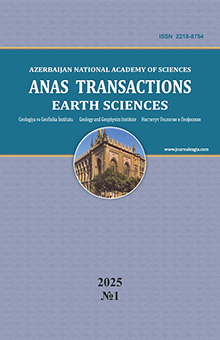Numerical modelling of thermohydrodynamic processes in fractured oil reservoir
Jalalov G.I.1, Rasulov M.A.1, Мirzoyeva D.R.2
1 Ministry of Science and Education of the Republic of Azerbaijan, Institute of Oil and Gas, Azerbaijan 9, F.Amirov ave., Baku, AZ 1000: dzhalalovgarib@rambler.ru; mresulov@gmail.com
2 Ministry of Science and Education of the Republic of Azerbaijan, Institute of Geology and Geophysics, Azerbaijan 119, H.Javid Ave. Baku, Az1143: dilazer@yandex.ru
Summary
Numerous reasons for the existence of hydrocarbon reserves, as well as the complexity of the processes associated with their formation and extraction emphasize the need for complex scientific approaches in the rational selection and metrological development of exploitation. The most important direction in these studies is the research for the mass transfer of hydrocarbons and the mechanisms of interfacial transition, taking into account changes in pressure and temperature in the collector under the multiphase fluid filtration in a porous medium. In fundamental studies on physical and mathematical modeling in order to predict development it is important to consider all the features of temperature anomalies during the movement of gas-liquid systems in hydrocarbon fields with different thermobaric conditions. In this paper, the problem of determining influential level of temperature anomalies on the distribution of thermodynamics fields during oil exploitation in fractured collector is solved. The algorithm of numerical solution is offered and numerous computer experiments have been conducted by means of software creation. The influence of the specific heat capacity of the liquid, the Joule-Thomson coefficient, wellbore volume influence coefficient, absolute permeability, fluid viscosity and deformation properties of the collector on exploitation process were assessed.
Keywords: mass-temperature exchange in porous medium, fractured collector, fluid filtration, finite difference method, Joule-Thomson coefficient
REFERENCES
Abasov M.T., Azimov E.Kh., Kuliev A.M. Hydro thermodynamic studies of wells in deep-seated fields. Azerbaijan State Publishing House. Baku, 1993, 176 p. (in Russian).
Alishaev M.G., Rosenberg M.D., Teslyuk E.V. Non-isothermal filtration in the development of oil fields. Nedra. Moscow, 1985, 271 p. (in Russian).
Aziz H., Settari E. Mathematical modeling of reservoir systems. Nedra. Moscow, 1982, 407 p. (in Russian).
Jalalov G.I., Ibrahimov T.M., Aliyev A.A., Gorshkova Ye.V. Modeling and investigation of filtration processes in deep oil and gas fields. Elm ve Takhsil. Baku, 2018, 382 p. (in Russian).
Chekalyuk E.B. Oil reservoir thermodynamics. Nedra. Moscow, 1965, 238 p. (in Russian).
Filippov A.I., Akhmetova O.V. Temperature field in the reservoir and well. Gilem. Ufa, 2011, 336 p. (in Russian).
Godunov S.K., Ryabenkii V.S. Finite difference schemes. Nauka. Moscow, 1972, 400 p. (in Russian).
Karachinsky V.E. Methods of geothermodynamics of gas and oil deposits. Nedra. Moscow, 1975, 168 p. (in Russian).
Le Veque R.J. Finite volume methods for hyperbolic problems. Cambridge University Press. Cambridge, United Kingdom, 2002, 558 p.
Ramazanov A.S. Theoretical foundations of thermohydrodynamic methods for studying oil reservoirs. Dissertation for the degree of doctor of technical sciences. Ufa, 2004, 269 p. (in Russian).
Ramazanov А.Ш., Parshin А.В. Temperature field in an oil-water saturated reservoir, taking into account oil degassing, Neftegazovoe delo, No. 1, 2006, pp. 1-17 (in Russian).
Richmyer R.D., Morton K.W. Difference methods for initial value problems Wiley-Interscience. New York, 1967, 405 p.
Samarskii A.A. Theory of finite differences schemes. Nauka. Moscow, 1977, 656 p. (in Russian).
Toro E.F. Riemann solvers and numerical methods for fluid dynamics. Springer-Verlag. Berlin Heidelberg, 1999, 624 p.
DOI: 10.33677/ggianas20230100092
